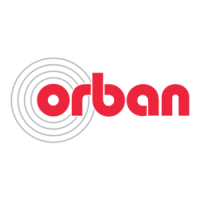OPTIMOD-FM DIGITAL INTRODUCTION
1-15
Digital Links
Digital links may pass audio as straightforward PCM encoding or they may apply
lossy data reduction processing to the signal to reduce the number of bits per sec-
ond required for transmission through the digital link. Lossy data rate reduction will
almost invariably distort peak levels and such links must therefore be carefully quali-
fied before you use them to carry the peak-controlled output of the 8500 to the
transmitter. For example, the MPEG Layer 2 algorithm can increase peak levels up to
4 dB at 160kB / sec by adding large amounts of quantization noise to the signal.
While the desired program material may psychoacoustically mask this noise, it is nev-
ertheless large enough to affect peak levels severely. For any lossy compression sys-
tem the higher the data rate, the less the peak levels will be corrupted by added
noise, so use the highest data rate practical in your system.
It is practical (though not ideal) to use lossy data reduction to pass unprocessed au-
dio to the 8500’s input. The data rate should be at least of “contribution quality”—
the higher, the better. If any part of the studio chain is analog, we recommend using
at least 20-bit A/D conversion before encoding.
Because the 8500 uses multiband limiting, it can dynamically change the frequency
response of the channel. This can violate the psychoacoustic masking assumptions
made in designing the lossy data reduction algorithm. Therefore, you need to leave
“headroom” in the algorithm so that the 8500’s multiband processing will not un-
mask quantization noise. This is also true of any lossy data reduction applied in the
studio (such as hard disk digital delivery systems).
For MPEG Layer 2 encoding, we recommend 384 kB / second or higher.
Some links may use straightforward PCM (pulse-code modulation) without lossy
data reduction. If you connect to these through an AES3 digital interface, these can
be very transparent provided they do not truncate the digital words produced by
the devices driving their inputs. Because the 8500’s output is tightly band-limited to
16.5 kHz, it can be passed without significant overshoot by equally well by any link
with 44.1 kHz or higher sample frequency.
Currently available sample rate converters use phase-linear filters (which have con-
stant group delay at all frequencies). If they do not remove spectral energy from the
original signal, the sample rate conversion, whether upward or downward, will not
add overshoot to the signal. This is not true of systems that are not strictly band-
limited to 15 kHz, where downward sample rate conversion will remove spectral en-
ergy and will therefore introduce overshoot.
If the link does not have an AES3 input, you must drive its analog input from the
8500’s analog output. This is less desirable because the link’s analog input circuitry
may not meet all requirements for passing processed audio without overshoot.
NICAM is a sort of hybrid between PCM and lossy data reduction systems. It uses a
block-companded floating-point representation of the signal with J.17 pre-
emphasis.
Older technology converters (including some older NICAM encoders) may exhibit
quantization distortion unless they have been correctly dithered. Additionally, they

